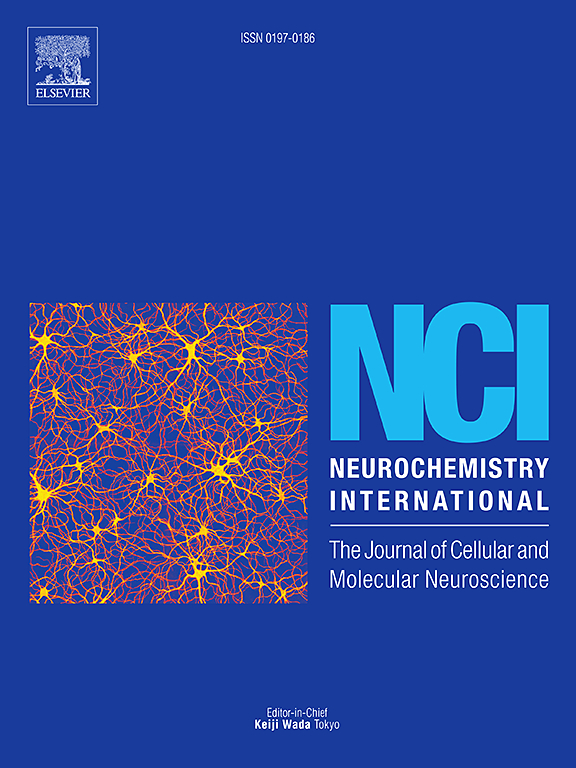经颅直流电刺激通过Netrin-1抑制神经元焦亡,减轻脑缺血再灌注损伤
IF 4
3区 医学
Q2 BIOCHEMISTRY & MOLECULAR BIOLOGY
引用次数: 0
摘要
焦亡在缺血性卒中早期发病机制中的重要作用强调了迫切需要有效的管理策略。经颅直流电刺激(tDCS)是一种调节脑活动的无创方式,已被证明通过抑制中风急性期的神经炎症来赋予神经保护作用。然而,tDCS对神经元焦亡影响的具体机制在很大程度上仍未被探索。采用中动脉闭塞(MCAO)模型建立成年雄性大鼠脑I/R损伤模型。tDCS治疗于术后24 h开始,连续6天。通过改进的神经系统严重程度评分(mNSS)评估神经行为缺陷,Western blot、免疫荧光染色、TUNEL染色、透射电镜(TEM)和酶联免疫吸附试验(ELISA)评估焦死相关蛋白的表达、细胞形态和炎症因子的水平。结果显示,tDCS显著降低NLRP3炎性小体依赖性焦亡蛋白(NLRP3、ASC、cleavaved - caspase -1和GSDMD-N)的水平,同时减少与焦亡相关的细胞膜穿孔和细胞死亡数量。此外,tDCS增加NTN-1的表达,通过过氧化物酶体增殖物激活受体γ (PPAR-γ)/核因子κ b (NF-κB)信号通路抑制NLRP3炎症小体的激活。NTN-1的下调逆转了tDCS的抗焦亡和神经保护作用。综上所述,tDCS通过ntn -1介导的PPAR-γ/NF- κB通路抑制神经元焦亡发挥神经保护作用,可能是缺血性脑卒中恢复的有效策略。本文章由计算机程序翻译,如有差异,请以英文原文为准。
Transcranial direct current stimulation attenuates cerebral ischemia-reperfusion injury by inhibiting neuronal pyroptosis via Netrin-1
The significant role of pyroptosis in the early pathogenesis of ischemic stroke underscores the urgent need for effective management strategies. Transcranial direct current stimulation (tDCS), a noninvasive modality for modulating brain activity, has been shown to confer neuroprotection by inhibiting neuroinflammation during the acute phase of stroke. However, the specific mechanisms underlying the effect of tDCS on neuronal pyroptosis remain largely unexplored. We established brain I/R injury in adult male Sprague Dawley rats through a middle artery occlusion (MCAO) model. tDCS treatment began 24 h after MCAO and lasts for 6 consecutive days. Evaluate neurobehavioral deficits through an improved Neurological Severity Score (mNSS), Western blot, immunofluorescence staining, TUNEL staining, transmission electron microscopy (TEM), and enzyme-linked immunosorbent assay (ELISA) were used to evaluate the expression of pyroptosis related proteins, cell morphology, and levels of inflammatory factors. The results showed that tDCS markedly reduced the levels of NLRP3 inflammasome-dependent pyroptosis proteins (NLRP3, ASC, cleaved-Caspase-1, and GSDMD-N), accompanied by a reduction in the number of cell membrane perforation and cell death related to pyroptosis. Moreover, tDCS increased the expression of NTN-1, which inhibited the activation of NLRP3 inflammasome through the peroxisome proliferator-activated receptor gamma (PPAR-γ)/nuclear factor kappa-B (NF-κB) signaling pathway. Knockdown of NTN-1 reversed the anti-pyroptosis and neuroprotective effect of tDCS. In conclusion, tDCS exerted neuroprotection by curbing neuronal pyroptosis through the NTN-1-mediated PPAR-γ/NF- κB pathway, and could be a useful strategy for ischemic stroke recovery.
求助全文
通过发布文献求助,成功后即可免费获取论文全文。
去求助
来源期刊

Neurochemistry international
医学-神经科学
CiteScore
8.40
自引率
2.40%
发文量
128
审稿时长
37 days
期刊介绍:
Neurochemistry International is devoted to the rapid publication of outstanding original articles and timely reviews in neurochemistry. Manuscripts on a broad range of topics will be considered, including molecular and cellular neurochemistry, neuropharmacology and genetic aspects of CNS function, neuroimmunology, metabolism as well as the neurochemistry of neurological and psychiatric disorders of the CNS.
 求助内容:
求助内容: 应助结果提醒方式:
应助结果提醒方式:


